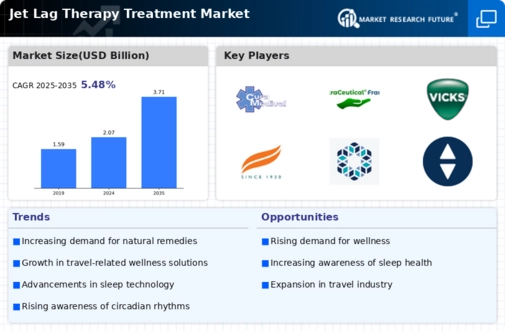Increase in Air Travel
The Jet Lag Therapy Treatment Market is experiencing a notable surge due to the increase in air travel. As more individuals embark on long-haul flights for business or leisure, the demand for effective jet lag treatments rises. In 2025, it is estimated that international air passenger numbers will reach approximately 4.5 billion, indicating a significant market opportunity for jet lag therapies. This increase in travel not only highlights the need for solutions to combat jet lag but also encourages airlines and travel companies to invest in partnerships with therapy providers. Consequently, the Jet Lag Therapy Treatment Market is likely to expand as travelers seek ways to mitigate the adverse effects of crossing multiple time zones.
Corporate Wellness Programs
The incorporation of jet lag therapy into corporate wellness programs is emerging as a key driver for the Jet Lag Therapy Treatment Market. Companies are increasingly recognizing the importance of employee well-being, particularly for those who travel frequently. By offering jet lag treatments as part of their wellness initiatives, organizations can enhance productivity and employee satisfaction. This trend is likely to expand as more businesses adopt comprehensive wellness strategies. In 2025, the corporate wellness market is projected to reach USD 87 billion, suggesting a significant opportunity for jet lag therapy providers to collaborate with corporations. This integration of jet lag treatments into corporate wellness programs could substantially boost the Jet Lag Therapy Treatment Market.
Rising Health Consciousness
The Jet Lag Therapy Treatment Market is benefiting from a rising health consciousness among consumers. As individuals become more aware of the health impacts associated with jet lag, they are actively seeking remedies to alleviate its effects. This trend is reflected in the increasing sales of dietary supplements and wellness products aimed at improving sleep and reducing fatigue. In 2025, the wellness market is projected to surpass USD 4 trillion, indicating a substantial opportunity for jet lag therapy providers. Consumers are likely to prioritize their health and well-being, driving demand for effective jet lag treatments that align with their lifestyle choices. This growing awareness is expected to propel the Jet Lag Therapy Treatment Market forward.
Advancements in Sleep Science
Recent advancements in sleep science are influencing the Jet Lag Therapy Treatment Market. Research indicates that understanding circadian rhythms and their impact on sleep can lead to more effective treatments for jet lag. Innovations in light therapy, melatonin supplements, and cognitive behavioral strategies are becoming increasingly popular. The market is projected to grow as these scientifically-backed methods gain traction among consumers. In 2025, the global market for sleep aids, which includes jet lag treatments, is expected to reach USD 100 billion, suggesting a robust interest in solutions that enhance sleep quality and overall well-being. This trend indicates a promising future for the Jet Lag Therapy Treatment Market.
Technological Innovations in Treatment
Technological innovations are playing a pivotal role in shaping the Jet Lag Therapy Treatment Market. The development of mobile applications and wearable devices that monitor sleep patterns and provide personalized recommendations is gaining traction. These technologies enable travelers to manage their jet lag more effectively by offering tailored solutions based on individual needs. In 2025, the market for health and wellness technology is expected to reach USD 200 billion, indicating a growing interest in tech-driven health solutions. As consumers increasingly rely on technology for health management, the Jet Lag Therapy Treatment Market is likely to benefit from these advancements, leading to more effective and accessible treatment options.

















Leave a Comment